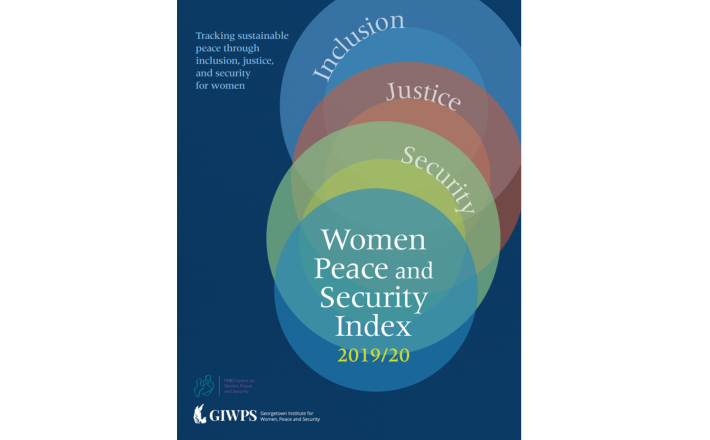Women Peace and Security Index 2019/20
Source: Georgetown Institute for Women, Peace and Security
This first update of the Women, Peace, and Security (WPS) Index provides important insights into patterns and progress on women’s well-being and empowerment around the world. It reflects a shared vision that countries are more peaceful and prosperous when women are accorded full and equal rights and opportunities. While just two years have passed since the inaugural WPS Index was published, major insights can be drawn from recent trends. The timing of this report offers opportunities for stakeholders to review and discuss challenges and to identify opportunities for transformative change in advance of the 20th anniversary of United Nations Security Council Resolution 1325 on Women, Peace and Security. The WPS Index incorporates three basic dimensions of women’s well-being—inclusion (economic, social, political); justice (formal laws and informal discrimination); and security (at the family, community, and societal levels)— which are captured and quantified through 11 indicators. The indicators are aggregated at the national level to create a global ranking of 167 countries. On a pilot basis in this report, we constructed subnational indexes for three of the world’s largest countries (China, India, and Nigeria), which reveal difference in performance within countries on many fronts. We are pleased to have collaborated with National Geographic and their expert team of researchers and designers who have created a series of striking graphics capturing and portraying key insights from the WPS Index. Their results are published in the November 2019 issue of the magazine.1 Some of the graphics are included in this report. Several innovations this year have enhanced the value of the index. First, improvements in data availability made possible the addition of 14 countries, expanding coverage to 167 countries— encompassing more than 98 percent of the world’s population. Second, greater data availability has enabled the use of data on the current (past 12 months) prevalence of intimate partner violence in place of data on women’s lifetime experience of intimate partner violence. This change permits tracking changes in prevalence over time. Third, we have used data revisions and updates since the inaugural edition of the index from the International Labour Organization, the United Nations, the World Bank, and other authoritative sources to continue to ensure the reliability of the data on which the index is based. While these are major improvements, the changes also mean that comparisons of scores and ranks between the 2017 and 2019 editions must be made carefully. This report examines changes in the underlying indicators and limits attention to changes in position on the index to the biggest country movers only. We hope that this year’s report is an important contribution to national and international efforts to accelerate progress on both the international commitment to women, peace, and security and the Sustainable Development Goals. The WPS Index will be updated again in 2021, serving to track progress toward women’s inclusion, justice, and security.
Click here to see the report.

This first update of the Women, Peace, and Security (WPS) Index provides important insights into patterns and progress on women’s well-being and empowerment around the world. It reflects a shared vision that countries are more peaceful and prosperous when women are accorded full and equal rights and opportunities. While just two years have passed since the inaugural WPS Index was published, major insights can be drawn from recent trends. The timing of this report offers opportunities for stakeholders to review and discuss challenges and to identify opportunities for transformative change in advance of the 20th anniversary of United Nations Security Council Resolution 1325 on Women, Peace and Security. The WPS Index incorporates three basic dimensions of women’s well-being—inclusion (economic, social, political); justice (formal laws and informal discrimination); and security (at the family, community, and societal levels)— which are captured and quantified through 11 indicators. The indicators are aggregated at the national level to create a global ranking of 167 countries. On a pilot basis in this report, we constructed subnational indexes for three of the world’s largest countries (China, India, and Nigeria), which reveal difference in performance within countries on many fronts. We are pleased to have collaborated with National Geographic and their expert team of researchers and designers who have created a series of striking graphics capturing and portraying key insights from the WPS Index. Their results are published in the November 2019 issue of the magazine.1 Some of the graphics are included in this report. Several innovations this year have enhanced the value of the index. First, improvements in data availability made possible the addition of 14 countries, expanding coverage to 167 countries— encompassing more than 98 percent of the world’s population. Second, greater data availability has enabled the use of data on the current (past 12 months) prevalence of intimate partner violence in place of data on women’s lifetime experience of intimate partner violence. This change permits tracking changes in prevalence over time. Third, we have used data revisions and updates since the inaugural edition of the index from the International Labour Organization, the United Nations, the World Bank, and other authoritative sources to continue to ensure the reliability of the data on which the index is based. While these are major improvements, the changes also mean that comparisons of scores and ranks between the 2017 and 2019 editions must be made carefully. This report examines changes in the underlying indicators and limits attention to changes in position on the index to the biggest country movers only. We hope that this year’s report is an important contribution to national and international efforts to accelerate progress on both the international commitment to women, peace, and security and the Sustainable Development Goals. The WPS Index will be updated again in 2021, serving to track progress toward women’s inclusion, justice, and security.
Click here to see the report.